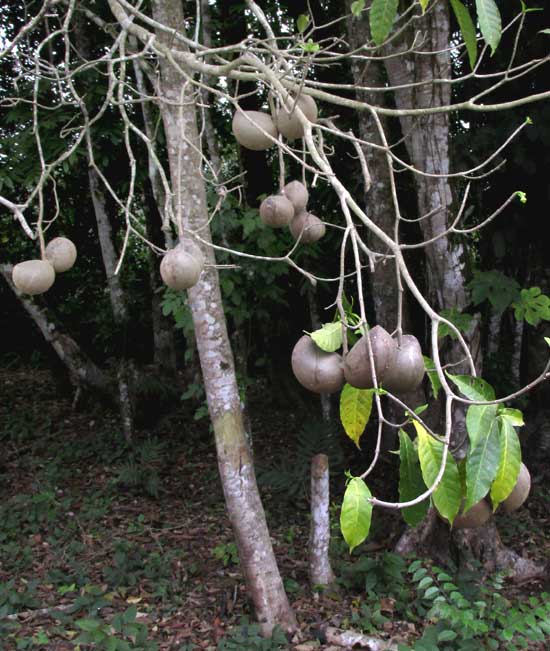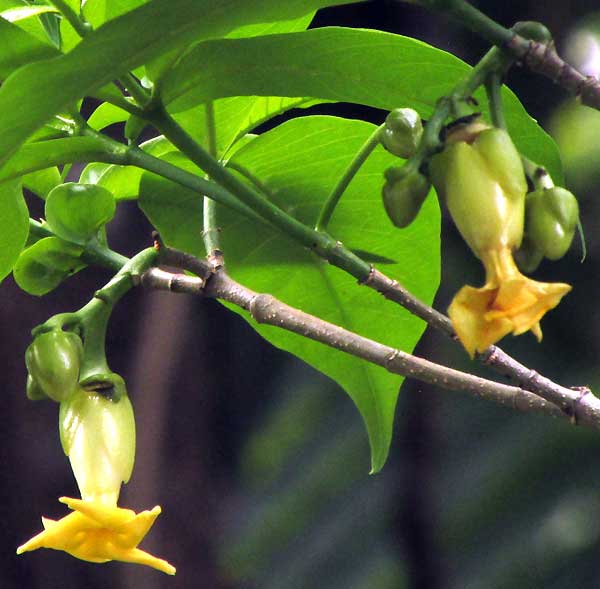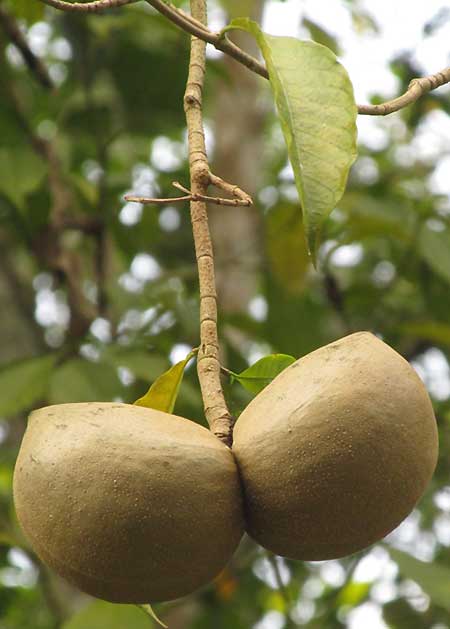Excerpts from Jim Conrad's
Naturalist Newsletter
from the May 22, 2016 Newsletter with notes from a visit in mid April to Lacanja Chansayab in the Lacandon Reserve; elevation 200m (650ft), N16.604°, W90.917°; Chiapas, MÉXICO
HORSE BALLS TREE
This April 14th as I wandered along backroads in the Lacandon community of Lacanja Chansayab in Chiapas's Lacandon Reserve in extreme southeastern Mexico, one of the most eye-catching plants was what's shown below:

Those are paired fruits on a mostly dry-season-leafless tree about 15 feet tall (5m). I was especially glad to see these fruits because back in the mid-1970s when I served as a naturalist on Maya-ruin-visiting boat trips in Guatemala's Petén Department -- just across the Usumacinta River from where I now was in Chiapas's Lacandon Reserve -- this little tree was one of the few I could identify for the tourists. And that was because of the fruits, which are about the size of eggs.
In fact, the name the backcountry Guatemalans taught me for the tree was Huevo de Caballo, translating literally to "Horse Eggs," though everyone knew to translate "eggs" to "testicles." Sometimes the tree also is called Cojones de Burro, but that just means Burro Balls, the same thing, and also there's Cojón de Gato (Cat Balls). People here just can't look at the tree without thinking "testicles." Furthermore, in this culture men don't have balls; they have eggs, and the concept is so pervasive and potent that the polite shopper doesn't walk into a shop and ask for huevos, the dictionary definition for eggs, but for blanquillos, meaning "little white things."
When you have paired capsular fruits like those in our picture, the first plant family to come to mind is the big Dogbane or Hemp Family, the Apocynaceae, and that's where the Horse Balls tree resides. It's STEMMADENIA DONNELL-SMITHII, found from southern Mexico and Belize south to Panama.
The Dogbane Family is a big one, and one feature many of its species have is that they're filled with milky white latex. Most plants exuding white latex traditionally are considered medicinal and/or poisonous, and that's the case with Stemmadenia donnell-smithii. The latex has been used to reduce swellings, cure external tumors, and in neighboring Quintana Roo people have been seen daubing the white latex over the breathing holes of parasites that burrow into the skin, suffocating them and making them easier to expel. Chemically, the tree's latex has been shown to contain a number of powerful alkaloids.
Entry with notes taken on April 2, 2019 during a camping trip to Rosario National Park on the east side of Sayaxché, Petén, northern GUATEMALA
HORSE BALLS IN FLOWER
During this trip to Rosario National Park, for the first time I noticed the Horse Ball Tree's interesting flowers, shown below:

Just to confirm the ID, I photographed some of the tree's hard-to misidentify fruits still hanging on branches though other branches bore flowers, shown below:

A distinctive feature of the flowers is that the pale greenish calyx from which the yellow corolla arises is so large relative to the corolla -- almost as long as the corolla tube -- and are more or less oval shaped. The yellow corolla's lobes arise from a slender tube, and expand outwardly in a spiraling, slightly reflexed manner. Corollas with such slender tubes and flaring lobes are said to be "salverform."
If you break a branch of this tree or pull off a fruit, the wound exudes copious white latex. In our earlier entry we passed along information about the latex's medicinal uses. In the 1984 treatment of the Apocynaceae Family in Guatemala by Paul Standley and Louis Williams (FIELDIANA: BOTANY vol. 24, PART VIII, #4), it was reported that in El Salvador the sticky latex was used for fastening the wrappers of cigarettes, by boys in making kites, and in general wherever an adhesive was needed.